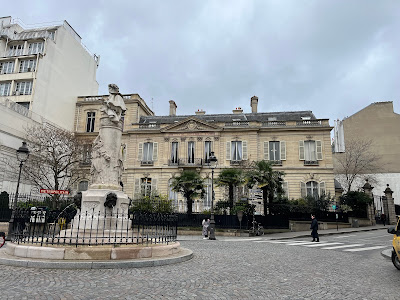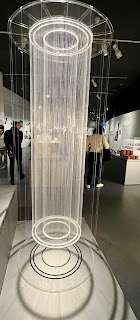Titled "Mise en Page", Andelman, founder of the publishing house "Just an Idea Books", takes over a big area of the ground floor, as well as the first floor, and creates a concept store featuring an eclectic array of items with a shared theme: books, literature and writing.
Among the bookstores featured, no surprise to find Shakespeare and Company, Paris...
...The London Review of Books bookstore, London...
...and New York's Strand Bookstore.
But this was a new one to us: Cow Books from Nakameguro, Tokyo! The tee-shirt caught our eye immediately. We wondered if the bookstore owners had ever visited Toby's Feed Barn in Pt. Reyes Station and seen their iconic Cow tee-shirt!
Everywhere you looked there were signs promoting the habit and art of reading, here with a photo of Marcel Proust on a book cover...
...or for younger readers, some favorite characters on the cover...
...even Charlie Brown got in on the act!
Then there were products tied to literary figures or to the world of writing and reading in general. Here's a bag of Honoré de Balzac tea leaves, for that all important cuppa!
And how many writers do their best work in their pajamas, (not to mention some blog writers, ahem) although maybe not in fancy Figaret pjs!
Maybe you've always fancied a custom-made reading stool...
...and who could resist some chocolate from La Mère de la Famille chocolate store, although that large egg would take some time to digest!
For the really high-end customer, this no doubt ranks as a "must buy": Bang & Olufsen speakers, covered with Jean Julien's "NouNou" characters.Tying the spaces and floors together, Jean Julien's whimsical Blue Man appears in giant size, here sitting on a pile of books, reading, towering over counters selling jewelry, perfumes and cosmetics.
Here, where he looks as though he is about to step up onto the balcony railing of the next floor up......and, finally, safely onto the second floor, he clambers onto his book-bed, ready to close his eyes and call it a day!
If you were not sleepy, though, the next room opens up into Le Bon Marché's elegant, large bookstore...
...where Monsieur Proust is featured prominently in the English language section. (I think they must have known Matthew would be visiting that day!)
Another recent outing took us to this imposing private house ("hôtel particulier") we have passed many times over the years, on Place St. Georges in the 9th arr. The former home of Adolph Thiers, 19th century journalist, historian, art and book collector and politician, today it houses the Dosne-Thiers Foundation, created in 1905, dedicated to the creation and maintenance of a library of the history of France.
The story of Adolph Thiers is rather more complex than that he was a journalist and a distinguished historian, however. Throughout the tumultuous 19th century history of France, he managed to both promote and discourage dissent, support the return of the Monarchy, and then oppose it. During his long life (1797-1877), he belonged to no fewer than six political parties, from Conservative, Liberal, Conservative, Independent and moderate Republican.
An ardent admirer of Napoleon, (they shared the fact of short stature) the Thiers house is full of images of the Emperor. This bust greets you inside the front door...
...several adornments reflect the Napoleonic era, such as this clock...
...and in almost every room, a painting of his hero, here shown with Josephine by an unknown artist. His crowning achievement in his devotion to Napoleon happened in 1840, when he arranged for the return of Napoleon's remains from St. Helena, and supervised the construction of the Emperor's tomb at Les Invalides.
Today, it is one of the more popular items on the tourist agenda, welcoming visitors from around the world, fascinated by the mystique of Napoleon. |
| Photo by Nadar |
Throughout his political life, Adolph Thiers held positions of high rank in government, until power swung in a different direction forcing him to step down, join the opposition, or even go into exile. During his lifetime, the country vacillated from a Republic, to the restoration of the Monarchy, and then back to being a Republic, and yet one more period of Monarchy rule, before ultimately establishing the Third Republic in 1870.
Through all the turmoil, whether in or out of power, Thiers remained a devoted student of history, writing a ten-volume history of the French Revolution, a sympathetic account which established his reputation as a man of letters. He followed this with History of the Consulate and the Empire, in twenty volumes, which became a big success at a time when the French public was looking for heroes. He also became an avid collector of art, an admirer of the paintings of Velasquez, a frequent visitor to galleries and museums in Paris.
In 1833, Thiers married Elise Dosne, and with help from his father-in-law, he purchased the land at what is now Place St. Georges, where he built his house. Here he built up his library and art and furniture acquisitions into a famed collection.
As a member of l'Académie Française, he acquired special robes to wear when he attended events as an "Académicien".
And he walked with a cane that included his own head as the knob!
 |
| "Le Rève" (Edouard Détaille) |
In 1870, the Franco-Prussian War ended in a humiliating French defeat. It
also led to the end of the Second Empire. Adolph Thiers had opposed the
war, and he was seen as the wise man who had foreseen the folly of
pursuing such a
policy without adequate military power. He was also clever enough to
remain
out of the national defense government set up after the fall of Napoleon III in September, and had no responsibility for the final French
surrender in January 1871. As a result, he was placed in the ideal
position to be appointed the first President of the Third Republic.
Through deft financial skills, President Thiers made the full payment of the indemnity owed to Germany in record time, ending the German military occupation of French territory, and earning the gratitude of towns and villages throughout Alsace and Lorraine.
The other side of the coin of Adolph Thiers' legacy, though, concerns his response to the Paris Commune. As the brand-new President of the brand-new Third French Republic, he sought to restore order by ruthlessly using troops to defeat the insurrection from March to May 1871. In so doing, he destroyed for many years the strength of French Socialists and workers’ movements. In retaliation, members of the Commune set fire and destroyed his house on Place St. Georges. Thiers had already moved many of his books, papers and paintings to the Louvre for safety. Some were then transferred to the Tuileries Palace, which in turn was burnt to the ground by the Communards.The family worked to rebuild its collections and real estate assets. In 1873, the architect Alfred Aldrophe was commissioned to build a new mansion on the ruins of the old one. In recent years, the gardens have become a public park.
Today, the Hôtel Dosne-Thiers is run by the Institut de France on behalf of the Fondation Dosne-Thiers. The former salons, bedchambers, dining rooms have become public reception areas that are rented out for conferences and personal or professional social gatherings. The spirit of Adoloph Thiers still resides here, however, in the very heart of the mansion: in the library. Here, scholars and historians come from all over the globe to study the over 150,000 volumes, brochures, periodicals, prints and drawings and manuscripts that preserve the history of France (political, military, general, social and administrative) from 1789 to 1914.
In his long lifetime and career, Adolph Thiers witnessed four changes of regime, deftly navigating each one to his own advantage, and held fast to the close connections between journalism, historical writing, and politics, a position not uncommon in nineteenth-century France. His image, as the writer Jean Vidalenc wrote, was of an "old, shrewd, and wise patriot, although, by those of left-wing sympathies, he was never regarded as anything but an inveterate enemy of social reform!"
A brief fashion update before we leave: white woolen coats are still to be seen everywhere, on the streets and in the shops, so definitely the "in" clothing item this winter. They are also showing up at the dry cleaners, whose owners are no doubt very happy to get the extra business! For spring, it's looking like *very* bright colors:
At the Théâtre du Châtelet's current presentation, though, there is a distinct absence of color. Matthew Bourne's London ballet company is in town with their interpretation of "Romeo and Juliet", music by Sergei Prokoviev. When a friend was unable to use her tickets, we leapt at the chance to see this singular production.
 |
| photo by Johan Persson |
Instead of the sumptuous colors of the Renaissance period normally associated with this ballet in both costumes and sets, Matthew Bourne presents a stark, dystopian futuristic world, predominantly in white. The Verona Institute houses troubled teenagers who are forcefully policed by prison guards and doctors. Freedom is limited, participation in the daily routines of exercise and medical injections are not optional. The prison bars stress the message.
Into this restricted world steps Romeo, dropped off by his parents who can no longer handle his errant behaviour. And so the relationship with Juliet begins. At the "social party" organized by the prison staff, Prokoviev's music guides the audience with its familiar motifs. The lovers entwine and begin the "balcony pas-de-deux", except here, it covers the whole stage in a series of beautiful fluid motions, the couple holding a kiss as they float up both sides of the stairs and both sides of the balcony. Truly breathtaking.
 |
| photo by Johan Persson |
With this new interpretation, there are no warring families or sword fights. Instead, there is sexual harassment (Tybalt, as the prison guard, assaults Juliet). In a drunken state he later comes upon the lovers and in the ensuing fracas, that brings the other dancers onto the stage, Tybalt pulls a gun, Mercutio is killed, and Romeo strangles Tybalt! (The program notes give warning of the violence). All this to the thunderous Prokoviev score. We were completely mesmerized.
At the end, Bourne departs from the Shakespeare narrative to reach his same tragic conclusion, the death of both Romeo and Juliet. As the curtain fell, the audience stood and gave a tremendous ovation that continued through many curtain calls. The setting, choreography, lighting, drama, dancing were spectacular, different, modern and "inoubliable". And then there was the music... It was the perfect evening out, and coming so close to our departure, a fine finale to this year's blog. Thank you for following our various adventures!
 |
“For never was a story of more woe |
Au Revoir!



































.jpg)












































